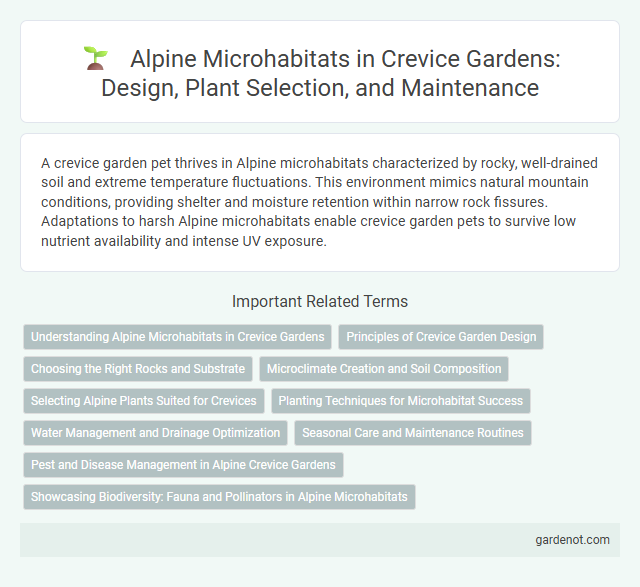A crevice garden pet thrives in Alpine microhabitats characterized by rocky, well-drained soil and extreme temperature fluctuations. This environment mimics natural mountain conditions, providing shelter and moisture retention within narrow rock fissures. Adaptations to harsh Alpine microhabitats enable crevice garden pets to survive low nutrient availability and intense UV exposure.
Understanding Alpine Microhabitats in Crevice Gardens
Alpine microhabitats in crevice gardens simulate the natural environments of high-altitude plants by emphasizing well-drained, rocky fissures with minimal soil and significant temperature fluctuations. These microhabitats support species such as saxifrage, alpine asters, and cushion plants that thrive under conditions of intense sunlight, cold nights, and limited nutrients. Understanding the precise moisture retention, soil composition, and aeration within these crevices is essential for cultivating resilient alpine flora and replicating authentic mountain ecosystems in garden settings.
Principles of Crevice Garden Design
Crevice garden design emphasizes narrow, deep gaps between rocks that mimic Alpine microhabitats, providing essential drainage and root aeration for specialized plants. Rocks are strategically stacked vertically to create microclimates with varying sun exposure, temperature, and moisture levels crucial for alpine species adaptation. These principles support diverse plant growth by replicating natural crevices where alpine flora thrive in extreme mountain environments.
Choosing the Right Rocks and Substrate
Selecting the right rocks for an alpine crevice garden involves prioritizing durable, weather-resistant stones such as granite, limestone, or sandstone, which provide natural crevices for alpine plants to root and thrive. The substrate should be well-draining and gritty, typically a mix of coarse sand, grit, and organic matter like leaf mold, ensuring moisture retention without waterlogging. Proper rock arrangement and substrate choice create microhabitats that mimic natural alpine conditions, supporting diverse plant growth and promoting healthy root development.
Microclimate Creation and Soil Composition
Alpine microhabitats within crevice gardens create unique microclimates by promoting temperature regulation and moisture retention essential for specialized alpine plants. The soil composition in these microhabitats typically consists of well-drained, gritty substrates with a high mineral content, mimicking natural mountain environments. These conditions support enhanced root aeration and reduced waterlogging, critical for sustaining delicate alpine flora.
Selecting Alpine Plants Suited for Crevices
Selecting alpine plants for crevice gardens requires focusing on species naturally adapted to shallow, well-drained soils and extreme temperature fluctuations typical of alpine microhabitats. Saxifraga, Draba, and Silene species thrive in narrow rock fissures, showcasing drought tolerance and compact growth ideal for tight crevices. Prioritizing plants with deep root systems and low water requirements ensures successful establishment and long-term vitality in crevice garden settings.
Planting Techniques for Microhabitat Success
In crevice gardens, mastering planting techniques for alpine microhabitats is essential to replicate natural rocky environments where plants thrive. Carefully selecting drought-tolerant and cold-hardy alpine species, such as Saxifraga and Sedum, enhances microhabitat success by ensuring root stability within deep, narrow crevices filled with well-draining, gritty soil. Strategic placement of plants to mimic natural sun exposure and moisture gradients improves growth and resilience, optimizing the microclimate for alpine flora survival.
Water Management and Drainage Optimization
Crevice gardens utilize narrow, vertical openings between rocks to mimic alpine microhabitats, enabling efficient water management by directing moisture directly to plant roots while preventing water stagnation. The strategic placement of stones enhances natural drainage, reducing the risk of root rot and promoting healthy growth for drought-tolerant alpine species such as saxifrages and sedums. Optimized drainage through these crevices replicates mountainous terrain conditions, preserving ideal moisture levels critical for alpine plant resilience and survival.
Seasonal Care and Maintenance Routines
Crevice gardens thrive in alpine microhabitats by requiring seasonal care tailored to harsh conditions, such as removing debris in spring to prevent fungal growth and applying mulch to conserve moisture during summer droughts. Winter maintenance involves protecting plants from freeze-thaw cycles with frost cloth or snow cover, while pruning ensures healthy growth and prevents overcrowding in narrow crevices. Regular monitoring for pests and soil erosion preserves the delicate balance of this specialized environment, optimizing plant health year-round.
Pest and Disease Management in Alpine Crevice Gardens
Effective pest and disease management in alpine crevice gardens relies on maintaining optimal microhabitat conditions that mimic natural alpine environments. Utilizing well-draining soil, proper rock placement for air circulation, and selecting pest-resistant alpine plant species minimizes the risk of infestations and fungal diseases. Regular monitoring and biological control methods ensure the health and resilience of plants adapted to the crevice garden's unique microenvironment.
Showcasing Biodiversity: Fauna and Pollinators in Alpine Microhabitats
Alpine microhabitats in crevice gardens support a diverse range of fauna, including specialized pollinators such as alpine bumblebees and solitary bees that thrive in high-altitude environments. These pollinators play a crucial role in the reproduction of endemic alpine flora, ensuring plant biodiversity within the harsh, nutrient-poor crevices. The interaction between cold-resistant insects and native plant species fosters a unique ecological balance, enhancing the resilience of alpine microecosystems.
Alpine microhabitat Infographic

 gardenot.com
gardenot.com